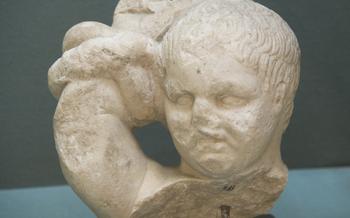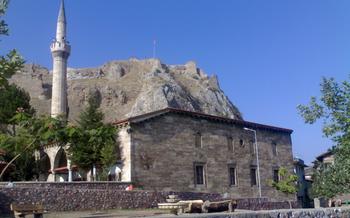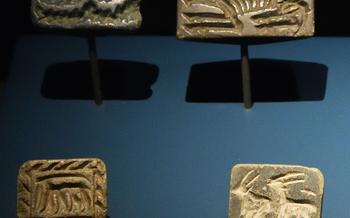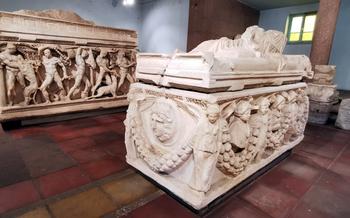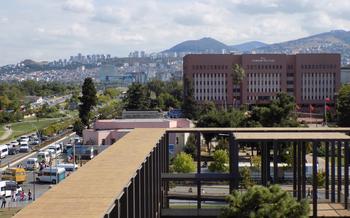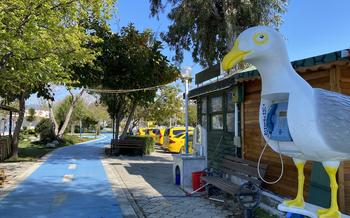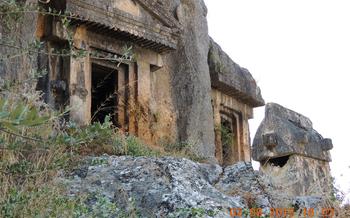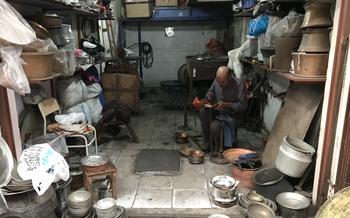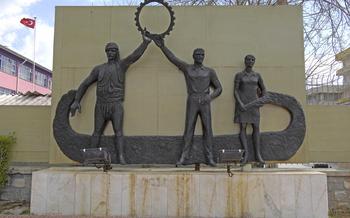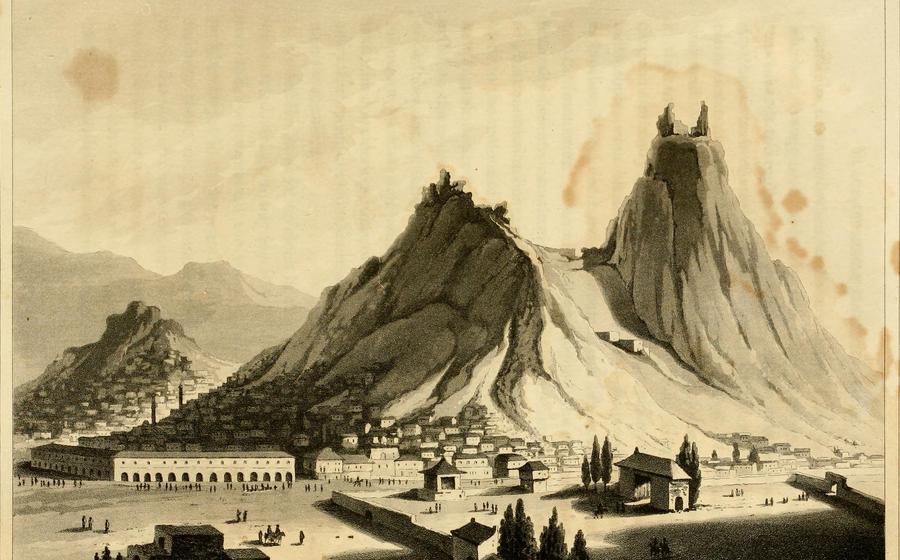
Comana Pontica Ancient City
- The Antiquity of Comana Pontica
- Exploring the Ruins
- Mythology and Legends
- Mosaics and Artifacts
- Comana's Role in the Roman Empire
- Comana Pontica Museum
- Nearby Attractions
- Photography Opportunities
- Local Cuisine and Hospitality
- Best Time to Visit
- Accommodation Options
- Transportation and Getting Around
- Budget and Costs:
- Safety and Precautions:
- Insider Tip: Unveiling Hidden Gems and Unique Experiences
The Antiquity of Comana Pontica
The ancient city of Comana Pontica, nestled in the verdant hills of Tokat, Turkey, holds a significant place in the annals of history. Its origins can be traced back to the 6th century BC, when it served as a religious center for the worship of the Anatolian goddess Ma. During the Hellenistic period, Comana Pontica flourished as a major city-state, minting its own coins and establishing trade relations with neighboring regions. In the Roman era, the city became an integral part of the Roman province of Galatia, serving as an important administrative and commercial hub. Comana Pontica's strategic location at the crossroads of trade routes contributed to its prosperity and growth. Archaeological excavations conducted in the area have unearthed impressive ruins, including temples, theaters, and public buildings, offering glimpses into the grandeur of this ancient metropolis.
Exploring the Ruins
Comana Pontica's ruins are a testament to its glorious past. Despite the ravages of time, several structures have survived, offering a glimpse into the city's grandeur. Among the most impressive is the Temple of Ma, which once served as the religious center of the city. The temple's massive columns and intricate carvings hint at the grandeur of the ceremonies held within its walls.
Equally captivating is the theater, with its well-preserved seating tiers and stage. Imagine the echoes of laughter and applause that once filled the air as audiences were entertained by performances and spectacles.
The agora, the city's bustling marketplace, is another highlight. Its colonnaded streets and open spaces evoke the vibrant atmosphere of trade and commerce that once took place here. Here, visitors can envision the lively interactions between merchants, shoppers, and travelers from far-off lands.
Other notable landmarks include the bathhouse, with its intricate heating system and well-preserved mosaics, and the nymphaeum, a monumental fountain that once adorned the city's center. These ruins, each with their own story to tell, provide a fascinating glimpse into the daily lives and cultural practices of Comana Pontica's inhabitants.
Mythology and Legends
Comana Pontica's allure extends beyond its physical remains, as it is deeply entwined with mythology and legends. The city was a major center of worship for the goddess Ma, a powerful Anatolian deity associated with fertility, healing, and war. Her temple, situated at the heart of the city, was a focal point of religious rituals and festivals.
According to myth, Ma was the daughter of the primordial goddess Cybele and the sky god Zeus. She was revered as a protector and guardian of the people, and her favor was sought through elaborate ceremonies and offerings. Devotees would gather in the temple to participate in sacred rituals, seeking blessings and divine guidance.
Legends surrounding Comana Pontica are rich and varied, adding to its mystical charm. One tale tells of a sacred spring near the temple, believed to possess healing properties. People would journey from afar to bathe in its waters, seeking cures for ailments and rejuvenation. Another myth speaks of a hidden treasure buried beneath the city, guarded by spirits and waiting to be discovered by a worthy seeker.
These myths and legends have been passed down through generations, weaving a tapestry of enchantment around Comana Pontica. Visitors to the ancient city can't help but feel a sense of awe and wonder as they explore the ruins, imagining the vibrant religious ceremonies and the mystical stories that once unfolded within its walls.
Mosaics and Artifacts
Comana Pontica's ruins are adorned with exquisite mosaics that offer a glimpse into the city's vibrant past. These intricate artworks, often depicting mythological scenes, religious ceremonies, or everyday life, are a testament to the artistic prowess of the ancient inhabitants. Visitors can marvel at the well-preserved mosaics adorning the floors of temples, villas, and public buildings.
Archaeological excavations have also unearthed a wealth of artifacts that provide valuable insights into the daily lives and cultural practices of the people of Comana Pontica. These include statues of deities, pottery vessels, coins, jewelry, and tools. The Comana Pontica Museum houses a remarkable collection of these artifacts, offering visitors the chance to explore the city's rich history and cultural heritage.
The mosaics and artifacts of Comana Pontica are not merely decorative elements; they serve as windows into the past, allowing us to understand the religious beliefs, social customs, and artistic traditions of this ancient city. These remarkable treasures bring history to life and make Comana Pontica a fascinating destination for anyone interested in exploring the depths of ancient civilizations.
Comana's Role in the Roman Empire
As the Roman Empire expanded its reach across Anatolia, Comana Pontica emerged as a significant city within the Roman province of Galatia. Its strategic location at the crossroads of trade routes made it a thriving center of commerce and administration. The Romans recognized the city's importance and invested in its infrastructure, leaving a lasting legacy visible in its architecture and urban planning.
The city's status as a major urban center is evident in its impressive public buildings, including temples, theaters, and an agora (marketplace). These structures showcased Roman architectural styles and engineering prowess, blending local traditions with Roman influences. The city's prosperity during the Roman period is further attested by the discovery of coins, pottery, and other artifacts bearing Roman imperial symbols and inscriptions.
Comana Pontica's role in the Roman Empire extended beyond trade and administration. It became a religious center, with the temple of the goddess Ma serving as a pilgrimage site for devotees from across the empire. The city's religious significance attracted visitors and pilgrims, contributing to its economic and cultural development.
Overall, Comana Pontica's incorporation into the Roman Empire brought about a period of growth and prosperity. The city's strategic location, coupled with Roman investment and patronage, transformed it into a vibrant hub of commerce, administration, and religious devotion.
Comana Pontica Museum
The Comana Pontica Museum, located in the heart of Tokat city, is a treasure trove of artifacts and exhibits that narrate the captivating history of the ancient city. Established in 1987, this museum houses a remarkable collection of archaeological findings unearthed during excavations at the Comana Pontica site.
Upon entering the museum, visitors are greeted by an array of intriguing displays that provide an immersive journey into the past. From intricate mosaics depicting scenes of daily life to statues of deities and emperors, each artifact tells a story of the city's rich cultural and religious heritage.
One of the highlights of the museum is the stunning mosaic floor discovered in the city's agora. Featuring vibrant colors and intricate designs, this mosaic offers a glimpse into the artistic prowess of Comana Pontica's artisans. Visitors can also admire a collection of pottery, jewelry, and coins, which provide valuable insights into the economic and social life of the city.
Through interactive displays and educational programs, the Comana Pontica Museum brings history to life for visitors of all ages. Whether you're a history buff, an archaeology enthusiast, or simply curious about the ancient world, this museum is a must-visit destination for anyone exploring the wonders of Comana Pontica.
Nearby Attractions
Beyond Comana Pontica's ancient ruins, the region offers a wealth of additional attractions to enhance your journey. History buffs can explore the nearby Tokat Castle, a magnificent fortress overlooking the city, or delve into the Tokat Museum, which houses artifacts from various eras. For nature enthusiasts, the scenic Tokat Waterfall cascades in full glory, while the adventurous can embark on hiking trails in the surrounding mountains or venture into the mysterious caves that dot the landscape. Outdoor enthusiasts can indulge in camping, fishing, and picnicking in the picturesque countryside, making the region a haven for outdoor recreation. Whether your interests lie in history, nature, or adventure, the region surrounding Comana Pontica promises a diverse array of experiences to enrich your travel itinerary.
Photography Opportunities
Comana Pontica is a visual feast for photographers of all skill levels. The ancient city's ruins, set against a backdrop of rolling hills and lush vegetation, create a picturesque landscape that is ripe for capturing stunning images.
The well-preserved temple, with its imposing columns and intricate carvings, is a must-photograph subject. The theater, with its rows of stone seats and stage, offers a unique perspective for capturing the grandeur of ancient performances. And the agora, with its bustling atmosphere and colorful stalls, is a great place to capture the essence of daily life in Comana Pontica.
Beyond the ruins, the surrounding countryside offers a variety of photo opportunities. The nearby waterfalls and caves provide a dramatic backdrop for nature photography, while the hiking trails wind through forests and fields, offering endless opportunities to capture the beauty of the region.
Tips for Taking Stunning Photos:
- Use a tripod to stabilize your camera and avoid blurry shots.
- Experiment with different angles and perspectives to find unique and interesting compositions.
- Take advantage of the natural light, especially during the golden hours of sunrise and sunset, to create warm and dramatic images.
- Don't be afraid to get close to your subjects to capture the details and textures of the ruins.
- Use a polarizing filter to reduce glare and enhance the colors of the landscape.
Local Cuisine and Hospitality
Tokat, the city where Comana Pontica is situated, offers a flavorsome journey through traditional Turkish cuisine. Tantalize your taste buds with the delectable Tokat kebab, a succulent skewer of grilled lamb seasoned with aromatic spices, or savor the rich flavors of Divle obruk, a hearty stew made with lamb, vegetables, and tender chickpeas. Don't miss the opportunity to indulge in the renowned Tokat baklavas, a flaky pastry filled with chopped nuts and sweetened with honey syrup, a true delight for any sweet tooth.
As you explore the ancient city, take a break and visit one of the local restaurants or cafes near the site. Immerse yourself in the warm hospitality of the locals as they welcome you with open arms. Engage in conversations, share stories, and learn about their vibrant culture. Whether it's a traditional Turkish breakfast with fresh bread, olives, and cheese, or a leisurely lunch accompanied by a glass of çay (Turkish tea), embrace the opportunity to connect with the friendly people of Tokat.
Best Time to Visit
The ideal time to visit Comana Pontica is during the spring (April-May) or autumn (September-October) when the weather is pleasant and mild. Temperatures range from a comfortable 15 to 25 degrees Celsius, making it ideal for exploring the ruins and outdoor activities. During these shoulder seasons, you'll also encounter fewer crowds, allowing you to enjoy a more intimate and immersive experience.
Summer (June-August) can be hot and dry, with temperatures soaring above 30 degrees Celsius. While this may not deter some visitors, it's important to be prepared for the heat and take precautions such as wearing sunscreen, staying hydrated, and seeking shade during the hottest hours of the day.
Winter (November-March) brings chilly weather, with temperatures dropping below 10 degrees Celsius and occasional snowfall. While the ancient city retains its charm during this time, some areas may be inaccessible due to snow and ice. However, if you're up for a winter adventure and don't mind bundling up, you may find the serene and snow-covered ruins to be a unique and memorable experience.
Comana Pontica hosts several festivals and events throughout the year, which can be a great time to visit and immerse yourself in the city's culture and traditions. Check the local tourism website or ask at your hotel for information on upcoming events during your visit.
Accommodation Options
When planning a trip to Comana Pontica, a variety of accommodation options are available to suit different preferences and budgets. In Tokat city, a short drive from the ancient city, visitors can find a range of hotels and guesthouses offering comfortable stays. For those seeking a unique experience, cave hotels and traditional Turkish houses provide an immersive cultural ambiance. These accommodations often feature authentic architecture, local décor, and stunning views of the surrounding landscapes.
For budget-conscious travelers, there are affordable options available, such as hostels and guesthouses with shared rooms. These provide a great opportunity to meet fellow travelers and share experiences. It's advisable to book accommodation in advance, especially during peak tourist seasons, to secure the best deals and availability.
Transportation and Getting Around
Comana Pontica is easily accessible by public transportation from Tokat city. Several buses depart daily from the main bus station, and the journey takes approximately 30 minutes. Once you arrive at the ancient city, you can explore the ruins on foot or take a guided tour.
For a more flexible and convenient option, renting a car is recommended. This allows you to explore the ancient city at your own pace and also visit other nearby attractions. Several car rental agencies are available in Tokat city, and prices start from around $30 per day.
Hiring a taxi is another option, especially if you are traveling in a group. Taxis are readily available in Tokat city, and the fare to Comana Pontica typically costs around $20.
Guided tours and organized excursions are also available from Tokat city. These tours usually include transportation, entrance fees, and a knowledgeable guide. Prices vary depending on the tour operator and the duration of the tour.
Budget and Costs:
Visiting Comana Pontica and exploring its rich history doesn't have to break the bank. Admission fees to the ancient city are quite reasonable, allowing you to immerse yourself in the past without spending a fortune. Transportation costs can be kept low by utilizing public transportation options, which connect Tokat city with the ancient site. For meals, there are budget-friendly options available in local restaurants and cafes, where you can savor traditional Turkish cuisine at affordable prices.
If you're a budget-conscious traveler, consider staying in hostels or guesthouses in Tokat city, which offer comfortable accommodations at reasonable rates. You can also opt for unique stays in cave hotels or traditional houses, providing an authentic Turkish experience without compromising your budget.
To save even more, take advantage of bargaining opportunities in local markets. Remember, the art of bargaining is deeply embedded in Turkish culture, so don't be afraid to negotiate for souvenirs, handicrafts, and other items. With a little skill and charm, you can score great deals while supporting local businesses.
Safety and Precautions:
Comana Pontica is generally a safe place to visit, but it's essential to exercise caution and be aware of your surroundings. As with any travel destination, it's advisable to keep your valuables secure and avoid walking alone at night. Respect local customs and traditions, and dress modestly when visiting religious sites. Be mindful of potential scams, especially when dealing with street vendors. Always negotiate prices before purchasing items and be wary of unsolicited services or tours. Familiarize yourself with local laws and regulations, and carry a copy of your passport and visa for identification purposes. In an emergency, dial 112 for assistance.
Insider Tip: Unveiling Hidden Gems and Unique Experiences
Beyond the well-known ruins, Comana Pontica holds hidden gems waiting to be discovered. Venture off the beaten path to find the secluded Temple of Mithras, a sacred site dedicated to the Persian god of light. Its well-preserved frescoes offer a glimpse into ancient religious practices. Take a leisurely stroll along the picturesque Comana River, where you can spot various bird species and enjoy the tranquility of nature. For a truly unique experience, consider staying in a traditional cave hotel in the nearby village of Tokat. These accommodations provide a charming and authentic glimpse into the region's cultural heritage.

